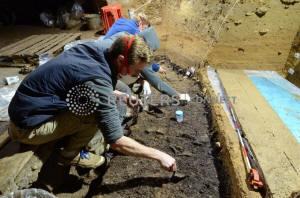Bulgarian fossils show early arrival of Homo sapiens into Europe
 Send a link to a friend
Send a link to a friend
 [May 12, 2020]
By Will Dunham [May 12, 2020]
By Will Dunham
WASHINGTON (Reuters) - Fragmentary bone
fossils and a molar found in Bulgaria dated to roughly 45,000 years ago
show that Homo sapiens populations swept into Europe - until then a
bastion for the Neanderthals - earlier than previously known, scientists
said on Monday.
Researchers said DNA from the five fossils from Bulgaria's Bacho Kiro
cave demonstrated they belonged to anatomically modern Homo sapiens.
This evidence resolved a debate over who made a remarkable array of
artifacts at the site including stone and bone tools and pendants made
of the teeth of cave bears - it was our species in the cave and not
Neanderthals.
The research pushes back by thousands of years the arrival of Homo
sapiens in Europe, a milestone in the history of a species that arose in
Africa about 300,000 years ago and then spread worldwide.
Human remains from the cave range from 43,000 to 46,000 years old while
associated artifacts were up to 47,000 years old, said
paleoanthropologist Jean-Jacques Hublin, director of the Department of
Human Evolution at the Max Planck Institute for Evolutionary
Anthropology in Germany.
"It looks like this is the time of the earliest wave of modern humans in
the mid-latitudes of Eurasia," Hublin added, with evidence existing of
Homo sapiens presence relatively soon after at similar latitudes from
Moravia to Mongolia.
Neanderthals - more robustly built than Homo sapiens - had already
inhabited Europe for hundreds of thousands of years. Hublin said the new
findings indicate the two species overlapped for perhaps 8,000 years
before the Neanderthals went extinct.
There is a debate over what doomed the Neanderthals, including the
possibility that our species wiped them out after thousands of years of
interactions including interbreeding that left an indelible mark on the
human genome.

[to top of second column]
|

Researchers engage in excavations at Bacho Kiro Cave where Homo
sapiens bones dating back about 45,000 years were recovered along
with a rich stone tool assemblage, animal bones, bone tools and
pendants near Dryanovo, Bulgaria, in an undated picture released May
11, 2020. Tsenka Tsanova/Handout via REUTERS

"In my view, Neanderthals disappeared from Europe because of the
competition with our species. However, this did not occur
overnight," said Hublin, lead author of research published in the
journal Nature alongside a second study in Nature Ecology &
Evolution.
Animal remains in the cave revealed hunting and butchering of cave
bears, bison, giant deer, horses, hyenas and lions.

Artifacts include pointed flint blades and numerous personal
ornaments including a bead made of mammoth ivory and the bear-tooth
pendants. Those pendants have striking similarities to ones made
later by Neanderthals in western Europe, indicating our closest
evolutionary cousins adopted aspects of Homo sapiens culture.
"The DNA evidence is now secure that Neanderthals and Homo sapiens
interacted when they came into contact with one another. In some
places those interactions may have even been 'friendly,' for lack of
a better word," said New York University anthropologist and study
co-author Shara Bailey. "We carry their DNA and they were influenced
by our cultural innovations."
(Reporting by Will Dunham; Editing by Sandra Maler)
[© 2020 Thomson Reuters. All rights
reserved.] Copyright 2020 Reuters. All rights reserved. This material may not be published,
broadcast, rewritten or redistributed.
Thompson Reuters is solely responsible for this content. |